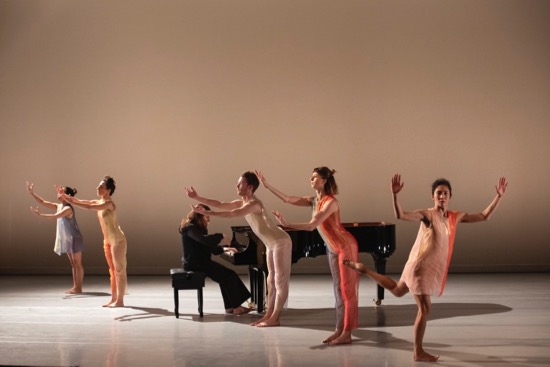
Count Hermann Carl von Keyserlink, so the story goes, had trouble sleeping at night in 18th-century Leipzig. So the amiable Johann Sebastian Bach composed thirty variations for harpsichord that his precocious and gifted pupil, 14-year-old Johann Gottheim Goldberg, might play at night to relax the insomniac. It is hard to imagine Bach’s Goldberg Variations helping anyone to get some shut-eye; the music is only occasionally calming. Notes ripple, cascade, run backward, chase one another through a musical forest.
New Work for Goldberg Variations, a 2017 collaboration between choreographer Pam Tanowitz and pianist Simone Dinnerstein, is arresting from the start. The Joyce Theater’s stage is dim. You can just make out six people standing near the dark hulk of a piano. Then you see Dinnerstein’s hands beginning to play Bach’s serene theme—an Aria as soothing as a lullabye. And gradually the instrument’s interior begins to glow.
Bach’s Goldberg Variations, BMV 988, has attracted choreographers before. Jerome Robbins, for instance, made his eponymous work for the New York City Ballet in 1971 (Dinnerstein played the music for the company’s 2016 performances at the Paris Opera). In 1986, Steve Paxton used improvisation in a remarkable solo that he danced to Glenn Gould’s two recordings (1982 and 1955) of Bach’s work. Stephen Petronio’s dancer Nicholas Sciscione studied the first half of Paxton’s material and performed Excerpt from Goldberg Variations (1986) to Gould’s recording during the 2016-2017 season of Petronio’s Bloodlines Project. Dinnerstein’s 2007 rendition of the Bach work received much acclaim in the recording industries’ “Best of” lists and was #1 on the Billboard Classical Chart.
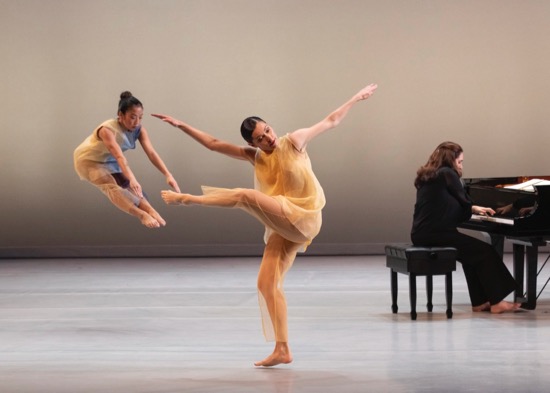
It was Dinnerstein who, interested in dance and its relation to music, approached Tanowitz with the proposal that they collaborate. Together with Bach they made a deep, stunningly beautiful dance that runs without intermission for about an hour and fifteen minutes. They had, of course, other collaborators: Davison Scandrett, who devised the lighting and visual design; Reid Bartelme and Harriet Jung, who designed the costumes; and the performers: Jason Collins, Christine Flores, Lindsey Jones, Maile Okamura, Melissa Toogood, and Netta Yerushalmy. (Victor Lozano was ill and unable to appear.)
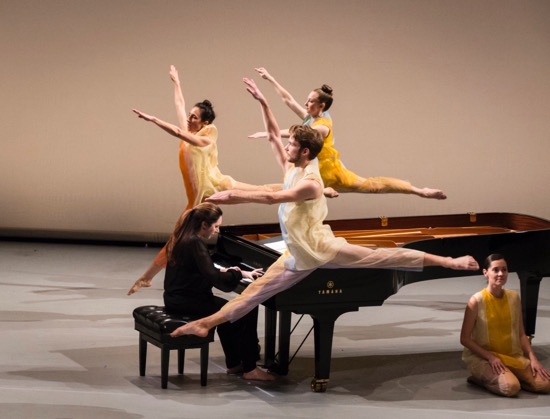
Wearing translucent tunics and pants, some of which bear broad vertical stripes in muted colors, the dancers forage in the music, not mickey-mousing its rhythm proper, but always relating to aspects of it. Coming and going, joining and separating, they may stitch a walking pattern onto the river of sound or explode into something more complex. Their straight legs and pointed toes slash and stab the air. They also twist, bend, or tilt their bodies, leap, hop, skip, spin, crawl, scuttle like crabs, skid down to sit on the floor, swing their arms, and touch their shoulders with their hands to make fledgling wings. Toogood holds one bent leg up in front of her and revolves slowly. They look like the sleek experts that they are, but Tanowitz’s choreography doesn’t shy away from having them occasionally handle jerkiness, awkwardness, or weakness.
At times, they circle the pianist. At times, one or more of them sit and watch her hands fly. Flores tunnels under the instrument. At separate times, either Okamura or Toogood holds onto the piano as if it were a classroom barre; Jones sits back to back with Dinnerstein on the piano bench and attempts to corroborate with her feet the rhythms of the musician’s hands.
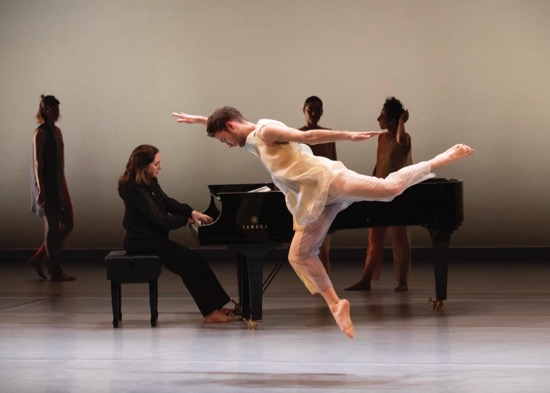
The dancers usually go about the patterns gravely, but, although they rarely touch, they’re almost always aware of one another. Occasionally they smile in a comradely way; occasionally one of them pulls another up from the floor. Once they hold hands to form a chain, but only once, as I recall, does Collins lift one of the women. Once Flores grabs his hand because she needs help balancing on one leg. Also once, Collins pushes Toogood offstage, although when she returns, she gets him into a ballroom-dance position for a few seconds. Tanowitz may interest us in a single dancer exploring the space and the music, or two dancers working in counterpoint while another spurts across behind them, or all six of them travelling together in immaculate unison. And more. A person may barely have entered the stage when she has to leave it (that happens with Yerushalmy more than once).
Bach’s variations, despite their dependence on the theme, differ vastly in speed and quality. It’s as if you’re hearing members of a close-knit family singing together, arguing, perhaps giving one person the floor. And unlike the harpsichord’s two keyboards for which Bach composed his work, the piano can sigh, speak quietly, march, become harsh, sing, and acquire whatever subtle mood Dinnerstein divines within the composer’s creation. Of the thirty variations, some are gentle, sweet-talking; others are assertive, even fierce. Some take their time; others hustle. Eight of them are canonic, their patterns chasing each other along. One is a fugue. One has the limping dotted rhythm of a gigue. The final variation is a quodlibet in which Bach (perhaps feeling giddy at having reached the finish line) juggled fragments of several folk tunes (the audience that knew him well would also have known the words that went with it: “Cabbage and turnips have driven me away, had my mother cooked meat, I’d have opted to stay”).
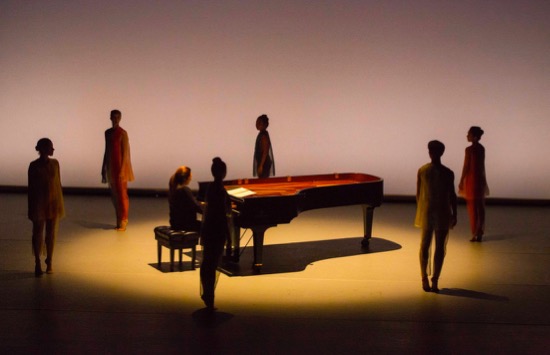
Some of the dancers shed their outer garments as New Work for Goldberg Variations progresses, the fabric on their form-fitting suits gleaming. Midway through the piece, Scandrett’s lighting starts offering variations too. He makes the cyclorama red, shading it into blue at the very top. He pins Dinnerstein in a downward-pointing spotlight against an orange cyc. He turns the atmosphere golden and, after a few minutes, bleaches it to a slightly greenish white. (All these changes of course, happen subtly.)
When Bach’s theme makes its slow reappearance, everything quiets down, including Dinnerstein’s miraculous hands. Before long every dancer has arrived onstage and the lights begin to dim very slowly. When it’s almost completely dark, you can still see these splendid people for a few more seconds, united with the fading centuries-old sounds.

This is a wonderfully written informative review, and not only about the dancing, but about the music as well. Many thanks.
Though I haven’t seen many works by Tanowitz, and wasn’t too impressed with what I saw, this review makes
me want to see this piece and give the choreographer another chance. Also want to hear that glorious music
again – especially if it’s played live by such a great musician.
Beautiful review — sad to have missed this.
Not that you were trying to make an exhaustive list of “Goldbergs,” but rather because it’s one I’ll never forget, Mark Haim’s version, with pianist André Gribou, was commissioned by Danspace Project and ADF. It was presented at Danspace in 1997 and reviewed in the Village Voice: http://www.markhaimart.com/uploads/1/2/0/6/12065947/village_voice_1997.pdf.
warm wishes,
Laurie
Thank you, Laurie, for your comment and especially for reminding me of Mark Haim’s fine solo. I hope those who read my post will want to click on the link you provided.